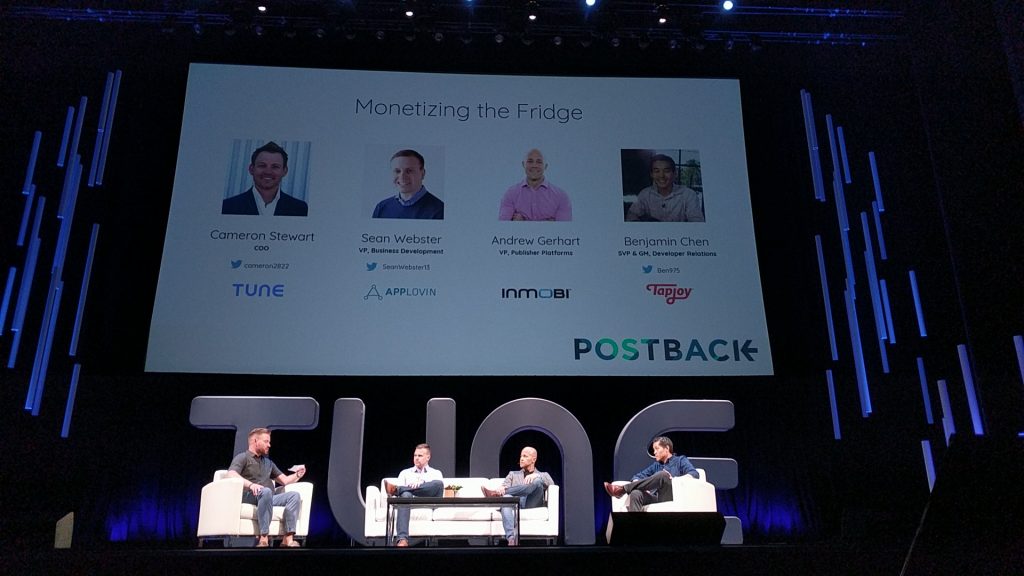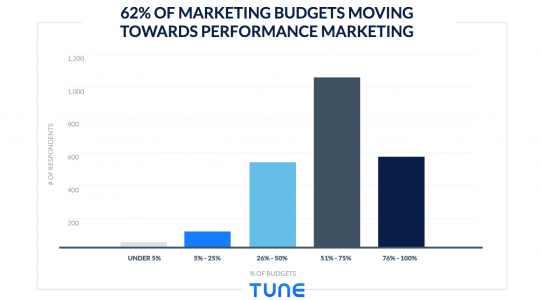
Leaders from top mobile adtech platforms discuss their predictions for the connected future in a panel at Postback 2018.
At Postback 2018, we invited advertisers, networks, and publishers from across the digital ecosystem to share their most exciting ideas and innovations. As usual, they didn’t disappoint.
In a Day 1 panel entitled “Monetizing the Fridge,” TUNE COO Cameron Stewart discussed predictions for the connected universe with experts from three leading mobile advertising platforms:
- Sean Webster, VP Business Development, AppLovin
- Andrew Gerhart, VP Publisher Platforms, InMobi
- Benjamin Chen, SVP & GM Developer Relations, Tapjoy
We’ve pulled some of the panel’s top questions and answers below.
Marketers are looking to your platforms to bridge supply in the connected universe. Let’s start with connected hardware, with mobile being at the center. Where do you see it going?
“I think the big thing that marketers want to see and want to know from us, and even developers want to know from us, is, ‘Is there supply? Is there a target audience that we can meet?’ And then another thing is, ‘Is there that target audience we can meet, and is there measurement for it? Can we actually track our return on investment, return on ad spend?’ … So if you’re looking at an app developer on Apple TV trying to drive an install, usually what they’re going to be trying to back it into is, ‘How many sales did I get from that?’ What’s my ARPDAU from the ads that I’m getting into it? And what we found with Apple TV is that frankly, we were just way too early. … It’s going to take time to evolve.” — Sean Webster, VP Business Development, AppLovin
“I think it has to be the perfect blend and work for all parties. It has to work for the brand advertisers, for the performance advertisers. It has to work for the consumers. And the ad experiences can’t be creepy in nature, right? … That doesn’t work for all parties in that way. You’re starting to see scale in some markets like OTT and CTV because it engages and works well for users, who are obviously adopting it and cutting the cord. It works for the brand advertisers. And so you have to find that perfect blend. But ultimately, I think the developers will follow. Whenever there’s a platform that works and there’s distribution, the developers will jump in and then it starts to take off.” — Andrew Gerhart, VP Publisher Platforms, InMobi
“I think from our standpoint, similar to what Sean and Andrew said, you’ve gotta have audience, you’ve gotta have measurement. But from our perspective at Tapjoy, we kind of look at everything as a bullseye. And the center of the bullseye right now for us is mobile, and the intersection of mobile games and mobile advertising. So when we look at what’s next, we look at the rings that go right outside the bullseye. … We kind of look at it more in terms of evolution versus revolution. … We think about a lot of things around esports and OTT because they’re similar formats that marketers are familiar with due to past experiences, but we feel like there’s a ton of upside and growth there because platform wars and content rights haven’t been won yet in those spaces.” — Benjamin Chen, SVP & GM Developer Relations, Tapjoy
How are you managing marketers’ expectations when they come in and want new supply, and it just isn’t there yet?
“I think that actually happened with playables initially. I think that’s a huge topic in mobile right now. … I remember two, three years ago, there was a lot of excitement because the quality seemed high. And let’s be real: it’s a lot sexier ad unit — you’re playing a game on a game, versus watching a 30-second non-skip video ad. There was a lot of interest in it, but there wasn’t a lot of supply. Well now, eventually, once the supply is there, look what’s happened: it’s catching on like wildfire, you’re seeing all of us mobile ad networks doing it, you’re seeing new mobile ad platforms actually popping up and doing it as well. I think the same thing is going to be happening once there is that supply that can be hit: there’s going to be more interest, and marketers will be there waiting in the wings.” — Webster
“I think there’s always early adopters. I think the challenge is scale. Some creatives or some marketers will come in and say, ‘Hey, we’d love to do AR, or VR, or these 360-video units.’ The challenge is the execution of that: Is there enough supply, is there enough measurement, can they actually execute, is there technology behind it, and the infrastructure set up to actually execute that unit? Oftentimes, no. So, yes, we can do it — but can you do it at the scale that they want, in order to blow out their budget?” — Gerhart
“When you look at two buckets of advertisers, there’s the pure performance marketers, who just want more conversions and more ROI against their spend, regardless of what the delivery mechanism is going to be. They want the output and the outcome. Then you’ve got brands, who want something a little more aesthetically pleasing and creative. And so, as Andrew mentioned, there’s kind of the hype curve, and then the reality and disillusionment that comes with it. I think right now, probably a good example of that is AR. I think a lot of people are talking about AR, looks really good, there’s a lot of press releases about AR. But if you look at the technical capabilities right now of AR — an SDK that supports AR is infinitely bigger than any SDK out there right now. And that’s going to curb publisher adoption until that gets solved. So it really comes down to what are the technical capabilities versus the pie in the sky ideas, and then how are you going to measure it.” — Chen
What are the user expectations for ads as we move forward into new devices?
“Looking at today’s market with the mobile ecosystem, or even looking at gaming to be more specific, you’re seeing a major trend. … The top 10 out of the top 15 game apps are hypercasual. … Almost 99% of their revenue is coming back from ads. I don’t think ads will ever be something that users will love, or be super thrilled about … but [users] will be willing to watch it if they get the content for free. At the end of the day, they want content for free. And I think that’s the biggest message. … If [users] are getting the content for free, that’s the prime expectation from them.” — Webster
“I think users’ expectations are higher than ever. They don’t want you to take their data; they want the content for free; they don’t want to see ads most of the time, they don’t want display ads or intrusiveness. So there’s a lot of responsibility on developers and marketers to integrate ads that are non-intrusive, and conscious of all those different things. … In mobile, the introduction of the rewarded video was a great step forward, right? You’re going to show me an ad, but I clearly get something in exchange for that. And I think that there are other ways to introduce advertising that are non-intrusive, and is a little bit better for the user experience, so I just think we have to keep those things in mind.” — Gerhart
“It’s really about enhancement and relevancy … We’ve moved from it’s ‘incentivized’ to it’s ‘rewarded,’ because consumers have spoken and said, ‘Within the environment that I’m in, [rewarded advertising] provides additional value to my experience within the content. So we like that.’ … And then relevancy: essentially the consumer wants the best, most relevant experience coming from their ads, without giving up a ton of data. It’s that Catch-22.” — Chen
Where are your companies looking to innovate?
“We have our own gaming studio now, so we could be building more content, or helping developers build more content. And with that, that could be on mobile, or if the supply is there, the target audience is there, some of the measurement that we talked about in this panel is there, then we could always be nimble and make that move to, say, doing a VR game, or building another go-around of the Apple TV.” — Webster
“From the InMobi perspective, I think there’s still a lot of work to be done in mobile. I think it’s great to see that the mobile app environment has matured quite a bit, but I think there’s still a lot of work to be done … Some of the forward-facing things we’re working on are really the OTT and CTV market.” — Gerhart
“From our perspective, there’s not another massive hardware shift coming anytime soon. So what you have to do is innovate within the ecosystems you’re already in, and find natural extensions. I think we [Tapjoy] kind of look at a little bit of everything. I think we’re interested where platform wars aren’t already won — where Facebook and Google haven’t already taken massive shares. … But it all starts with the audience: Where’s the audience?” — Chen
To hear what else the panel had to say on topics such as esports, wearables, and influencers, watch the full session below.
Author
Becky is the Senior Content Marketing Manager at TUNE. Before TUNE, she handled content strategy and marketing communications at several tech startups in the Bay Area. Becky received her bachelor's degree in English from Wake Forest University. After a decade in San Francisco and Seattle, she has returned home to Charleston, SC, where you can find her strolling through Hampton Park with her pup and enjoying the simple things in life.




Leave a Reply
You must be logged in to post a comment.